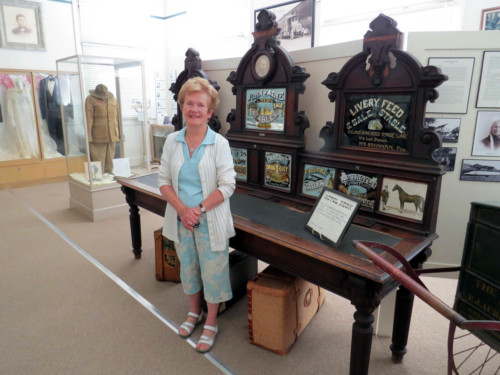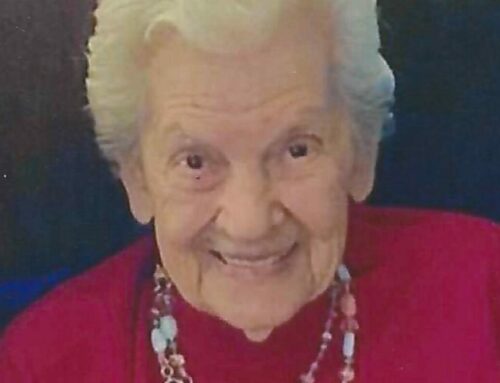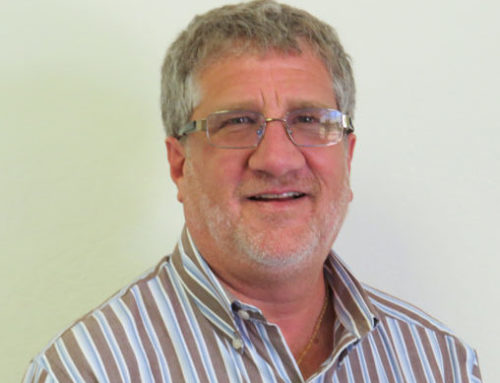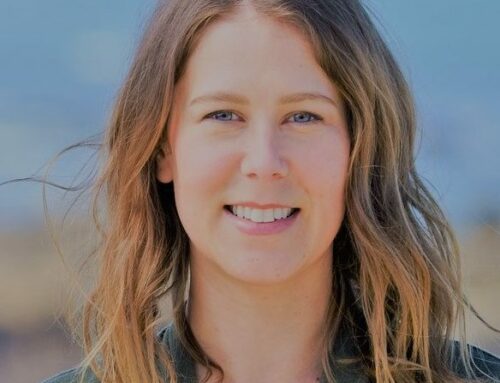Connie Rogers, 81, and now president of the Gilroy Historical Society, served on the Gilroy City Council from 1993-1997

Connie Rogers in Gilroy Museum. Morgan Hill file photo.
By Kelly Barbazette

Kelly Barbazette
Where other people may see a barrier, Connie Rogers sees an opportunity for change. Each accomplishment during her 57 years in Gilroy — from being one of the first Gilroy City Councilwomen to finding a way to keep the Gilroy Museum open during an economic downturn — is fueled by her unflappable can-do spirit. And the 81-year-old Rogers isn’t slowing down.
“One thing I’ve found out is there are a lot of obstacles in life, but there is a way around them,” she told me. “You might have to take a detour to get there. There are other ways to work on what you think is important.”
I had the pleasure of chatting with the Vermont native recently about what brought her to Gilroy and how her contagious affection for the community was conceived and nourished.
She and her husband, Jim, will celebrate 60 years of marriage this August. They met in college in Vermont. After graduation, they moved to a U.S. Air Force base in Washington state where Jim served as an officer before moving to San Jose. Jim graduated from San Jose State University with a graduate degree in teaching and the couple moved to Santa Cruz. They settled in Gilroy in 1966 when the town had a population of about 12,000 people.
Jim began teaching at Brownell Middle School while Rogers worked as a social worker for Santa Clara County until 1975. They had two sons. When the oldest was in kindergarten at El Roble Elementary, Rogers got involved in the parents club and quickly found herself leading it as the president of the PTA. She also joined the South County chapter of the United Way and became involved with the Gilroy branch of the American Association of University Women. The latter, founded in 1965, “promotes equity for all women and girls, lifelong education, and positive societal change,” which appealed to Rogers.
“It was a group that was always trying to show that women had brains and capabilities and should be treated equal to men,” she said.

Rogers became a member of the Gilroy Planning Commission in 1989. She served through 1991 and was elected to the Gilroy City Council in 1993 and served four years. She said the issue of whether to put filters on all computers in Gilroy’s public library — Rogers opposed them — played a key role in her re-election defeat.
“I certainly learned a lot about the experience,” she said. “And being on the city council gave me even more confidence about getting certain things done and not being afraid to speak up and saying what you believe in.”
In the late 1990s, she became involved with the Gilroy Historical Society. She said her interest in history is due in part by growing up in Vermont, the 14th state, which traces its history back to the 1600s.
“It was an area I was always interested in, but I didn’t really know much about Gilroy’s history until I got involved with (the historical society),” she said.

“Gilroy is the third oldest city in our county,” she said. “It’s always been a crossroads, which makes it important.”
President of the Gilroy Historical Society for more than two decades, Rogers is among the volunteers who helped create the Gilroy Historical Paseo, a pathway lined with murals and interpretative panels depicting the city’s past. Itlinks the downtown’s shops and restaurants to free parking lots between Fifth and Sixth streets.
“I think it turned out great thanks to the real artists. Just last week I took two third grade classes through there,” she said.
The Paseo has become a stop on the tour of the Gilroy Historical Museum, located down the street, for third graders learning about their state and local history. Between two and four third grade classes visit the museum monthly.
Rogers often talks to students about the importance of a free library and shows them the brass pole at Station 55 Cocina, home of the city’s original fire house. They tour Old City Hall Restaurant as well. It’s the site of Gilroy’s original City Hall and once housed the city’s first jail, courtroom and judge’s chambers, as well as early police and fire departments.
Housed in the historic 1910 Carnegie Library Building, the Gilroy Museum hosted more than 1,300 visitors last year on its walking tours, field trips, museum tours, and presentations.
However, it hasn’t always been as active. The city owns the museum. During the housing crisis and economic downturn in 2008, the city’s mayor suggested padlocking it and furloughing the workers. Rogers feared shuttering it wouldn’t be good for its collection, which boasts more than 25,000 items relating to the history of Gilroy and the south Santa Clara County region. She asked if it could stay open if she could find enough volunteers. When she got the green light, she recruited 40 volunteers.
However, she knew more would be needed to keep it open.
“I felt the best way to keep the museum permanently open is to pay a manager,” Rogers said.
For 10 years, the Historical Society held fundraisers and actively sought donations and raised more than $400,000 — enough money to pay a part-time manager a modest wage for many years.
The museum hired Susan Voss. One week later the COVID-19 pandemic struck, forcing the museum to close its doors. Voss started working in the museum again in August 2020 and the volunteers returned in 2021.
Asked of her proudest accomplishment while working with the Gilroy Historical Society, Rogers said, “I think keeping the museum open, hands down . . . It’s very rewarding for us to see visitors and attendance picking up. COVID was awfully hard on everybody.”
She said it’s always interesting to see who visits the museum and attends the free monthly walking tours through the city’s historic districts.
“Sometimes it’s natives, and I always learn from them. Other times, it’s people who are new to town,” she said. “It’s a way of getting acquainted with their new community.”
All of her work for the town that has become her home is rooted in a desire to help make things better and being a contributor to the community she loves, she said.
“I’m a real believer in community and trying to be a unique place that people are proud of. We don’t want to be just like every other town.”
She and Jim enjoy being surrounded by so much open space — one of the qualities that makes Gilroy unique for them.
In her free time, they like to hike at local county parks. In the springtime she often helps Jim check on the nest boxes for bluebirds along trails as part of the California Bluebird Recovery Program.
Asked what advice she would give to other women pursuing their goals, she said,
“Have confidence in your capabilities and also know that you can enlist friends for help when you need it because no one does things alone,” she said. “They really don’t. You’ll need support from others.”
Kelly Barbazette, a former journalist for Bay Area newspapers, is a freelance writer. She lives in Gilroy with her husband and two daughters.






